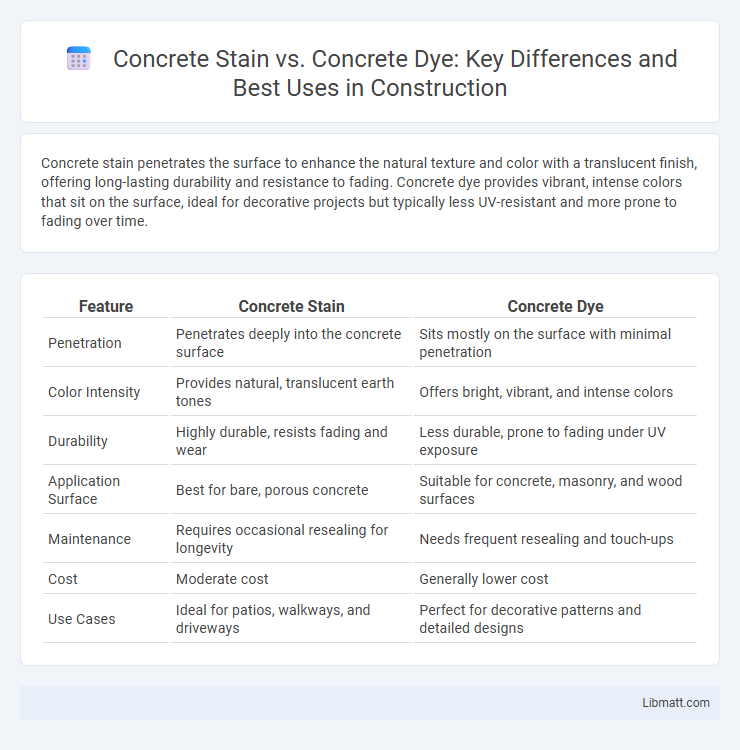Concrete stain penetrates the surface to enhance the natural texture and color with a translucent finish, offering long-lasting durability and resistance to fading. Concrete dye provides vibrant, intense colors that sit on the surface, ideal for decorative projects but typically less UV-resistant and more prone to fading over time.
Table of Comparison
| Feature | Concrete Stain | Concrete Dye |
|---|---|---|
| Penetration | Penetrates deeply into the concrete surface | Sits mostly on the surface with minimal penetration |
| Color Intensity | Provides natural, translucent earth tones | Offers bright, vibrant, and intense colors |
| Durability | Highly durable, resists fading and wear | Less durable, prone to fading under UV exposure |
| Application Surface | Best for bare, porous concrete | Suitable for concrete, masonry, and wood surfaces |
| Maintenance | Requires occasional resealing for longevity | Needs frequent resealing and touch-ups |
| Cost | Moderate cost | Generally lower cost |
| Use Cases | Ideal for patios, walkways, and driveways | Perfect for decorative patterns and detailed designs |
Introduction to Concrete Stain and Concrete Dye
Concrete stain penetrates the surface, offering translucent color changes that highlight the texture and natural imperfections of concrete, while concrete dye provides vibrant, intense colors by bonding directly with the surface. Stains are typically acid-based or water-based, reacting chemically with the concrete to create long-lasting effects, whereas dyes are often solvent-based or water-based pigments that deliver a wider range of bright hues. Both products enhance the aesthetic appeal of concrete surfaces but differ significantly in application, durability, and overall finish.
Understanding the Key Differences
Concrete stain penetrates the surface to enhance the natural texture and color variations of concrete, offering a translucent, variegated finish that fades gradually over time, while concrete dye provides a more vibrant, uniform, and intense color by bonding to the surface without penetrating deeply. Stains typically use acid-based or water-based chemical reactions to alter the concrete's appearance permanently, whereas dyes rely on solvents or water for quick drying and predictable color results. Choosing between stain and dye depends on factors like desired color intensity, longevity, and texture effects, with stains preferred for natural, earthy tones and dyes favored for bright, consistent colors.
How Concrete Stains Work
Concrete stains work by penetrating the surface and chemically reacting with the minerals in the concrete, creating a permanent, translucent color that enhances the natural texture. Acid-based stains produce variegated, marble-like effects through a chemical reaction, while water-based stains use pigments to achieve more consistent and vibrant hues. Both stains preserve the concrete's texture and durability, making them ideal for long-lasting decorative finishes.
How Concrete Dyes Work
Concrete dyes penetrate the surface of the concrete to impart vibrant and translucent colors that highlight the natural texture and patterns. These dyes are typically solvent- or water-based, allowing them to absorb quickly into the pores without leaving a surface film, which enhances durability and color retention. Your choice of concrete dye ensures a rich, long-lasting finish ideal for decorative applications where bright, intense hues are desired.
Application Methods Compared
Concrete stain penetrates the surface and is typically applied with a sprayer or brush, allowing for a translucent, natural look that highlights the concrete's texture. Concrete dye is water or solvent-based and is applied with a sprayer or roller, offering vibrant, uniform colors that sit more on the surface. Your choice depends on the desired effect and durability, as stains tend to be longer-lasting while dyes provide more intense pigmentation.
Color Range and Finish Options
Concrete stain offers a wide color range with earth-toned, translucent hues that penetrate the surface, enhancing the natural texture and providing a variegated, matte to satin finish. Concrete dye delivers more vibrant, intense colors with a broader palette, including bright and neon shades, and produces a uniform, glossy to semi-gloss finish. Both products allow customization, but stains emphasize subtle, natural aesthetics, whereas dyes cater to bold, striking visual effects.
Durability and Longevity
Concrete stain offers superior durability and longevity compared to concrete dye, penetrating deeply into the surface to resist fading and weathering over time. Concrete dye provides vibrant color but tends to fade faster due to its surface-level application and susceptibility to UV exposure. Choosing concrete stain ensures your outdoor surfaces maintain their aesthetic appeal longer with minimal maintenance.
Ideal Use Cases for Stains and Dyes
Concrete stains are ideal for enhancing outdoor surfaces like patios, driveways, and walkways due to their penetrating properties and natural, translucent finish that resists fading under sunlight. Concrete dyes suit indoor applications such as polished floors and decorative features, offering vibrant, uniform color with quick drying times and compatibility with concrete sealers. Both options provide versatile color solutions, with stains preferred for durability in harsh environments and dyes chosen for intense, bright coloration on smooth surfaces.
Maintenance and Care Tips
Concrete stain offers long-lasting color with minimal maintenance, requiring only occasional cleaning and resealing every few years to preserve its finish. Concrete dye penetrates the surface, providing vibrant colors that may fade more quickly and benefit from regular cleaning and prompt sealing to protect from UV exposure and wear. Your choice between stain and dye affects the upkeep routine, with stains generally demanding less frequent maintenance for enduring durability.
Choosing the Right Option for Your Project
Concrete stain offers a translucent, variegated finish that enhances surface texture and is ideal for outdoor patios or walkways requiring durability and UV resistance. Concrete dye delivers more vibrant, uniform colors perfect for indoor projects and decorative concrete where bold hues and quick application are priorities. Evaluating factors such as exposure to sunlight, desired color intensity, and project location ensures selecting the best option between concrete stain and dye for long-lasting aesthetic results.
Concrete stain vs concrete dye Infographic

 libmatt.com
libmatt.com